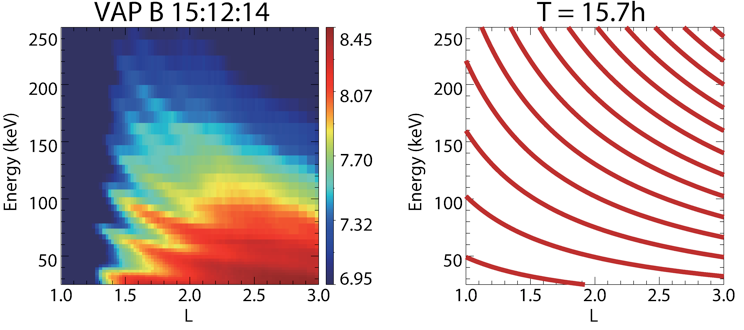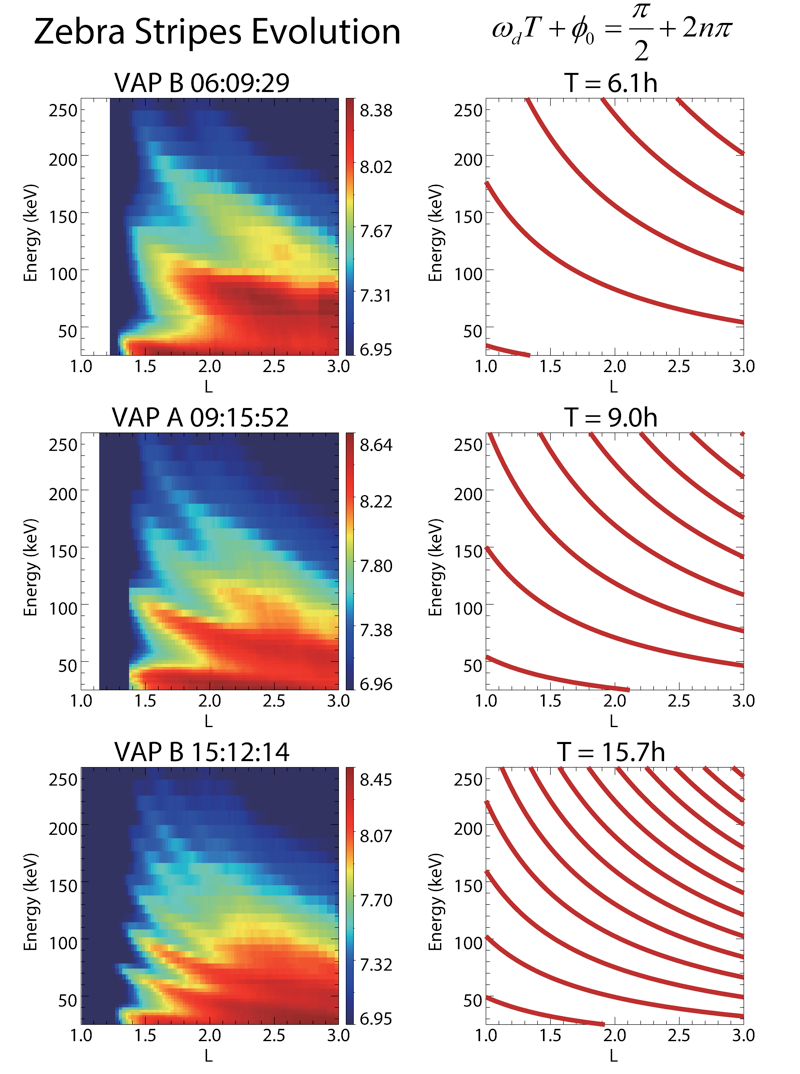地球内辐射带中的电子“斑马纹”是存在于内辐射带电子通量的能量-空间分布图中的一种有趣的现象。在前人的研究中,斑马纹的形成存在波粒共振与非共振两种机制,缺乏系统的观测证据来区分到底是哪一种机制在起作用。借助Van Allen Probes的高质量数据,我们首次给出了电子“斑马纹”演化规律的直接观测,并且通过对一年数据的统计分析给出了斑马纹结构和演化规律的定量结果。结果显示斑马纹为电子漂移频率坐标系中的一维周期性结构,结构的周期的倒数与时间成正比。这样的结果否定了波粒共振产生“斑马纹”的机制,该种机制将产生固定的条纹。通过考虑非共振粒子的运动轨迹,我们解析的给出了在单色波动或静态电场下的粒子的分布及其演化,解析模型与前面的观测结果完全一致。解析分析进一步支持了非共振产生斑马纹的机制,同时揭示了斑马纹的形成来源于粒子的周期性漂移。研究还发现斑马纹的强度与地磁活动指数呈现显著的正相关,这表明驱动斑马纹形成的电场与地磁活动相关。

该成果近期发表在Journal of Geophysical Research: Space Physics上(Liu Y. et al. (2016), 121, doi: 10.1002/2015JA022077, in press),文章链接http://onlinelibrary.wiley.com/doi/10.1002/2015JA022077/full
文章作者为:刘鹰,宗秋刚,周旭之,J. C. Foster,Robert Rankin。
Liu Y. et al. (2016),J. Geophys. Res. Space Physics, 121, doi: 10.1002/2015JA022077, under press.
Structure and Evolution of Electron "Zebra Stripes" in the Inner Radiation Belt
Y. Liu1, Q.-G. Zong1, X.-Z. Zhou1, J. C. Foster2, R. Rankin3
1Institute of Space Physics and Applied Technology, Peking University, Beijing, China.
2Haystack Observatory, Massachusetts Institute of Technology, Westford, MA, USA.
3Department of Physics, University of Alberta, Edmonton, Alberta, Canada.
"Zebra stripes" are newly found energetic electron energy-spatial (L-shell) distributed structure with an energy between tens to a few hundreds keV in the inner radiation belt. Using high-quality measurements of electron fluxes from Radiation Belt Storm Probes Ion Composition Experiment (RBSPICE) onboard the twin Van Allen Probes, we carry out case and statistical studies from April 2013 to April 2014 to study the structural and evolutionary characteristics of zebra stripes below L="3." It is revealed that the zebra stripes can be transformed into evenly spaced patterns in the electron drift frequency coordinate: the detrended logarithmic fluxes in each L-shell region can be well described by sinusoidal functions of drift frequency. The `wave number' of this sinusoidal function, which corresponds to the reciprocal of the gap between two adjacent peaks in the drift frequency coordinate, increases in proportion to real time. Further, these structural and evolutionary characteristics of zebra stripes can be reproduced by an analytic model of the evolution of the particle distribution under a single monochromatic or static azimuthal electric field. It is shown that the essential ingredient for the formation of multiple zebra stripes is the periodic drift of particles. The amplitude of the zebra stripes shows a good positive correlation with Kp index, which indicates that the generation mechanism of zebra stripes should be related to geomagnetic activities.


